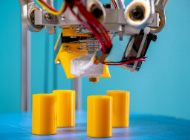
3D printing technologies have different capabilities and design restrictions. Thus, when creating models for 3D printing, several things must be considered to be able to print quality 3D parts successfully.
Designing for 3D printing is the foundation of making high-quality 3D parts. Product designers should have enough knowledge in designing 3D parts without compromising other aspects such as appearance and performance measures.
To prepare and educate product designers, here are 6 key considerations when designing 3D parts. Read on below.
-
A strong base should be designed carefully
With 3D printers, a model is printed out one layer at a time. Then, material such as PLA or ABS is melted and extruded onto the print bed. But during the printing process, it would be very critical for the first layer to adhere to the print bed for the whole time.
If the model loses its adhesion to the bed while printing, the entire 3D part will be damaged. Most of the 3D printing fails are caused by lack of adhesion when printing.
To ensure that the model will stick to the print bed, there are a few fine-tuning to be done. Firstly, the print bed must be levelled using adjustment screws. This is for the end of the extruder to be perfectly parallel with the entire surface of the print bed.
Adjustments in the software such as increasing the first layer extrusion thickness, adding brim or raft and turning off the fans for the first layer can also be made.
-
Overhangs
With 3D printing, any part of the model that is supported by thin air will most likely to fall. Hence, every layer should have some underline material over it to be printed.
Overhangs are areas of the 3D model that are either required to be partially supported by the layer below or don’t need to be supported at all. Every printer has a certain limit on the angle where support structures are not required. In the case of FDM and SLA printers, the approximate limit is 45ᵒ.
A 3D model that has an overhang of more than 45ᵒ is difficult to print. Thus, 3D designers should consider limiting the overhangs of the model. In this way, using support structures can also be avoided.
-
Part orientation
When designing, a specific printing orientation of the 3D part is required. For 3D models that are designed for structural application, its layer lines can be a weak point if the 3D part is not oriented properly. Moreover, the joints between each layer are susceptible to delamination. This is similar to how the wood grain in a piece of timber behaves.
This potential problem can be avoided by simply orienting the model so that the X/Y axis plane will be stronger. Layers are printed in Z-axis direction. But continuous extrusion happens along the X/Y axis plane. Thus, they must be strong enough.
-
Warping
In 3D printing, the materials used for creating 3D parts undertake physical change. This means that these materials are melted, sintered, scanned with UV light and solidified before a new object is formed. The heating and cooling phase of these materials can cause some parts of the model to warp during printing.
Most of the time, 3D models with large and flat surfaces are susceptible to warping. To avoid warping, 3D designers should use correct machine calibration. Moreover, having enough surface adhesion between the print bed and 3D part must be considered.
-
Mock-ups
For 3D parts that are designed with critical tolerances, consider isolating that specific area of the model then print it out separately. In this manner, the shape can be tested out without worrying about the rest of the 3D model.
-
Checking the G-code
Before sending the 3D design to the printer, consider checking the visualization of the G-code. G-code is a set of computer instructions that are generated to tell a printer how to print a specific model. A G-code visualiser will show what the model will look like as it will be printed.
With the G-code visualiser, 3D designers can have the last chance to spot any mistakes in the 3D model before it is printed.
Conclusion
The designing phase may be one of the crucial stages when creating 3D parts. Thus, product designers must be well-prepared. They must also have enough knowledge of different design limitations and the key considerations when designing. In this way, 3D printing failures can be avoided even before the actual printing process.
If you have any concerns about 3D printing and design, you may contact a 3D printing service provider in Sydney Australia. They can provide 3D printing-related services that will suit your preferences. These services include 3D design and modelling, custom 3D printing and many more.







